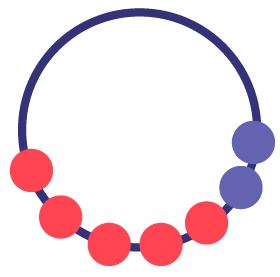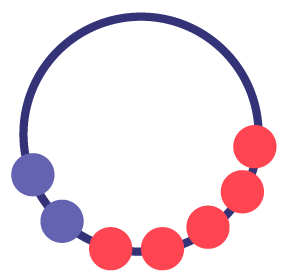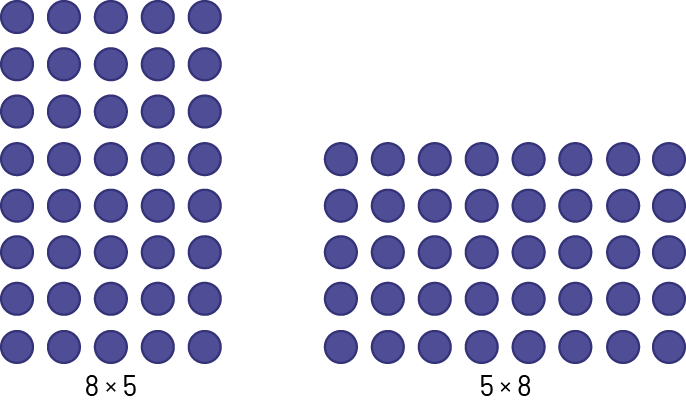B2.1 Use the properties of operations, and the relationships between multiplication and division, to solve problems and check calculations.
Activity 1: I Am Making a Necklace! (Commutative Property of Addition)
Ask students to make a necklace by stringing 5 red beads and 2 blue beads, then suggest they write the corresponding number sentence.
\(5 + 2 = 7\)

Have students turn the necklace and write the corresponding number sentence.
\(2 + 5 = 7\)

Then suggest that students compare the two number sentences and answer the following questions:
- What do you notice about the order of the beads?
- What do you notice about the amount of beads?
- Why is the quantity the same in both cases?
- Change the amount of beads on the necklace and write two number sentences. Compare the sentences. What do you notice?
- If you do the same process using a large quantity of beads on the necklace such as 100, 300 or 500, what can you say about the quantities you observe?
Note: Repeat the activity with larger quantities. Repeat the activity, asking students to move to look at the necklace in the other direction instead of turning it.
Source: translated from Guide d'enseignement efficace des mathématiques de la maternelle à la 3e année, Modélisation et algèbre, Fascicule 2, Situations d'égalité, p. 91.
Activity 2: Train Cars (Associative Property)
Introduce students to 3 train cars built with interlocking cubes of different colours.

Ask the students to help Mr. Bontrain, the conductor, who wants to combine two cars together without changing their order. How can he combien the cars?
Represent each possible combination using the interlocking cubes and write the corresponding number sentence. To avoid using parentheses, use boxes to illustrate the cars.
Note: Cars can be combined in two ways:
- combine cars 1 and 2;

- combine cars 2 and 3;.

Ask students the following questions:
- Are there other possible car combinations? How do you know?
- What is the sum of the interlocking cubes that form the train in each case? (Both sums are equal to 7; they are the same)

- How is it possible that the sum remains the same even though there are different combinations of cars? (These are the same interlocking cubes combined differently; the total amount of cubes does not change)
- Would this work with three other numbers? Demonstrate this with a double open number line and a number sentence.
Ask them to explain to another student what they observed. Afterwards, ask them:
- What could you write in your collective math journal about what you discovered today?
Repeat the activity using a larger number of cars.
Note: Students who are familiar with the commutative property, might change the order of the terms to be added (for example, 4 + 2 + 1). If so, ask them to justify why the order can be changed. Otherwise, simply mention that the order of the cars cannot be changed, since they are attached to the track in this way.
Source: translated from Guide d'enseignement efficace des mathématiques de la maternelle à la 3e année, Modélisation et algèbre, Fascicule 2, Situations d'égalité, p. 99-100.
Activity 3: The Array
Ask students to represent \(5 \times 8\) and \( 8 \times 5\) using arrays:

Proceed in the same way with various other multiplications of two 1-digit numbers.
Ask questions to support students in understanding the commutative property of multiplication, such as:
- What do you notice?
- How many counters are there in your array? rows? columns?
- Ask the students to move 90° around the array and ask "How many are there now?"
- What is the product of 5 and 8? What other multiplication fact is similar to it? How do you know?
- By rotating the arrays, what other pairs of numbers give the same product?
Source: translated from Guide d’enseignement efficace des mathématiques de la 1re à la 3e année, Numération et sens du nombre, p. 42.
